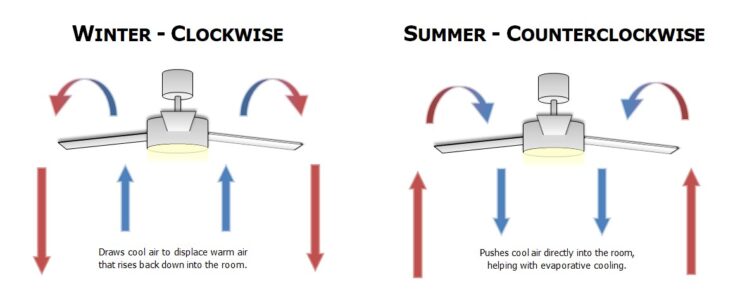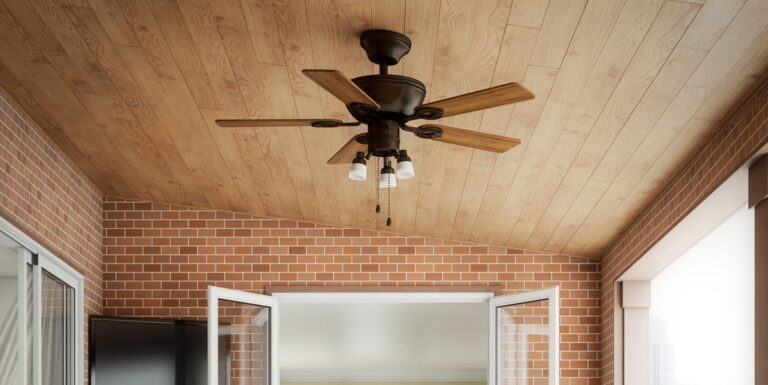Equipping your home with new elements is never an easy process. The bigger and more important the commodity is, the more time and resources one needs. When it is a gadget or a piece of furniture that is supposed to last you at least a decade, the decision becomes even more difficult. Well, it can get more overwhelming when the item in question is both a gadget and a piece of furniture. This is perhaps the best way to describe the ceiling fans that we talk about today. It is not easy to determine the right one for your needs and the size is usually the biggest issue.
Choosing the right ceiling fan size is crucial for both aesthetics and functionality. A fan that is too small may not effectively circulate air, while an oversized fan can overpower a room. So, how can you determine the size of a ceiling fan to ensure the perfect fit for your space? In this article, experts of Todaysfans will explore some key factors to consider when selecting the right size ceiling fan for your needs. Their insight will be of tremendous help for your ceiling fan shopping.
1. Room Size

The first step in determining the size of a ceiling fan is to measure the dimensions of your room. Use a tape measure to determine the length and width of the space in feet. For larger rooms, you may also want to consider measuring the height of the ceilings. Do not forget to include the furniture that may get in the way of smaller rooms. For a very large room, there may even be a need for two fans.
2. Blade Span
The blade span refers to the diameter of the circular path that the fan’s blades create when in motion. It is an essential factor in choosing the right fan size. As a general rule, the blade span should be proportionate to the size of the room. There are some guidelines for the customers to get a better idea of what they should aim for. Here are some recommended blade span ranges based on room size:
- For rooms up to 75 square feet: 29 to 36-inch blade span.
- For rooms between 76 and 144 square feet: 36 to 42-inch blade span.
- For rooms between 144 and 225 square feet: 44 to 50-inch blade span.
- For rooms between 225 and 400 square feet: 50 to 54-inch blade span.
- For rooms larger than 400 square feet: 54-inch blade span or larger.
3. Ceiling Height
Ceiling height is another important consideration. For obvious reasons, there must be enough clearance between the fan and the floor for the people to move comfortably. It is very annoying and potentially dangerous when you feel like you must duck while walking underneath it. For ceilings that are 8 feet or lower, a flush-mounted or low-profile ceiling fan is ideal to ensure adequate clearance. For higher ceilings, you can consider fans with down rods to achieve proper air circulation. As a general guideline, for each additional foot of ceiling height beyond 8 feet, you can add 6 inches to the download length. This leaves plenty of space for safe operation.
4. Airflow Efficiency

In addition to size, it is crucial to consider the airflow efficiency of the ceiling fan. This is measured in cubic feet per minute (CFM). The higher the CFM, the more air the fan moves. It is recommended to choose a fan with a CFM rating appropriate for the room size to ensure effective air circulation. Again, this is very subjective and it depends on the purpose of the room and how much traffic it will experience daily. If you need a lot of efficiency, aim for higher CFM ratings.
5. Style and Aesthetics
While size and functionality are key, don’t forget to consider the style and aesthetics of the ceiling fan. The fan should complement the overall décor of your space and match it nicely. It is enough on its own to change the whole look and feel of the room so it needs to follow what is already there. Nowadays, ceiling fans come in a wide range of styles, finishes, and designs, allowing you to find one that matches your taste and enhances the visual appeal of your room. The last thing you want is a fan that sticks out and ruins what the space has going on.
6. Noise Level
Another aspect to consider is the noise level of the fan. No one wants a noisy fan that disrupts the peace of a room. When researching ceiling fans, read reviews or consult with the store to find fans that operate quietly without compromising performance. There are fans that are very quiet, quiet enough to stay on while you sleep. They produce next to no noise and are a joy to have in a home or a workspace.
7. Energy Efficiency

Energy efficiency is a significant consideration when selecting a ceiling fan. Look for fans with the Energy Star label, as they meet strict efficiency guidelines and can help save on energy costs in the long run. These fans are designed to move air efficiently while consuming less electricity. While somewhat more expensive to purchase initially, it balances out and is more profitable down the line.
8. Professional Guidance
If you are unsure about the right size or have specific requirements for your space, it’s always a good idea to consult with a professional. They can provide expert advice based on your room’s dimensions, layout, and specific needs, ensuring that you make an informed decision. Ask them at the store or find some professional reviews from specialists online.
Final Thoughts
By considering factors such as room size, blade span, ceiling height, airflow efficiency, style, noise level, and energy efficiency, and seeking professional guidance if needed, you can confidently determine the right size ceiling fan for your space. Investing in a properly sized ceiling fan will not only enhance the comfort and aesthetics of your room but also provide efficient air circulation and help create a pleasant environment for years to come. So, take the time to measure, research, and select the perfect ceiling fan that meets your requirements and complements your style.
Related Posts:
- 20 Best Gaming Headset Under 50$ 2024 - for PC, PS4,…
- Top 10 Best Paint Sprayer For Cabinets 2024 -…
- Top 10 Best Modem For Gaming 2024 - For Optimum Gaming Speed
- Top 10 Best Office Chair Under 200 2024 - Ergonomic…
- Top 10 Best Office Chair Under 100 2024 - Cheap,…
- Top 10 Best Power Inverter for Car 2024 - Keep Your…







